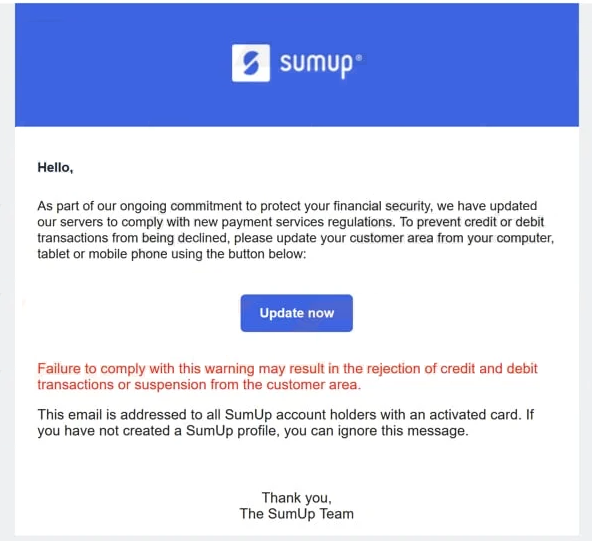Remove “SumUp – Update Your Profile” email
The “SumUp – Update Your Profile” email is part of a phishing campaign aiming to steal users’ SumUp login credentials. The email is disguised as a notification from SumUp, supposedly informing recipients about updates to their servers and the necessity for recipients to update their customer area. According to the email, if they do not comply, credit and debit card transactions may be declined in the future. If users engage with the email, they will be taken to a site that asks them to log in to their accounts. If users do as asked, their login credentials would be stolen and their accounts potentially accessed.
This phishing email campaign targets businesses using SumUp, a British financial technology company that provides card readers and online payment/bank account systems. The email claims that SumUp has updated its servers to comply with new payment service regulations. To supposedly prevent credit or debit transactions from being declined, users are asked to update their customer area by clicking on the provided button.
If users click the “Update now” button, they will be taken to a site that’s not working at the time of writing. However, the site is likely a phishing site that asks users to log in to their accounts. If users type in their login credentials, they will be stolen and transferred to the malicious actors operating this phishing campaign. This could allow malicious actors to access users’ accounts.
Cybercriminals are always after login credentials, especially for email and finance-related accounts. Users have to be very careful with their login credentials as successful phishing attacks can have very serious consequences. In this case, the consequences may be money-related.
The full “SumUp – Update Your Profile” email is below:
Subject: Our terms and conditions of use have changed. Please update your profile now to avoid your account get suspended!
Hello,
As part of our ongoing commitment to protect your financial security, we have updated our servers to comply with new payment services regulations. To prevent credit or debit transactions from being declined, please update your customer area from your computer, tablet or mobile phone using the button below:
Update now
Failure to comply with this warning may result in the rejection of credit and debit transactions or suspension from the customer area.
This email is addressed to all SumUp account holders with an activated card. If you have not created a SumUp profile, you can ignore this message.
Thank you,
The SumUp TeamSupported by SumUp
SumUp Limited is an e-money institution authorised and regulated by the Central Bank of Ireland (reference number: n°C195030).
How to recognize phishing emails
Some phishing emails are more obvious than others. This particular “SumUp – Update Your Profile” email is immediately obvious as its first line gives it away. The email uses a simple “Hello” to greet you, without addressing you using your name. All emails from a financial company whose services you use will address you by name. Unless a phishing email is part of a targeted attack against a specific person, they will usually address recipients using generic words like User, Member, Customer, etc., or not address them at all, as is the case with this email.
When you receive unsolicited emails with attachments or links, you need to confirm the sender’s email address before engaging with the email in any way. Many low-effort phishing emails are sent from fake or dubious email addresses. While some more sophisticated phishing emails may appear to come from legitimate addresses, a quick online search can help verify their legitimacy. If you can’t find any details about the address, it’s likely a phishing scam. There are no records showing SumUp using the email addresses from which the “SumUp – Update Your Profile” email was sent, so it would be an immediate giveaway.
Another telltale sign of phishing is spelling and grammar mistakes, as well as unprofessional language. Phishing emails often contain numerous mistakes, such as typos, wrong punctuation, or irregular formatting, while legitimate emails, particularly those related to account security, are generally well-written and look very professional. While this “SumUp – Update Your Profile” email does not contain obvious spelling mistakes, its phrasing looks unprofessional.
No matter how sophisticated a phishing email may be, examining the links/buttons can reveal its true nature. By hovering your mouse over the links, you can see where they will take you. If a link looks suspicious in any way, avoid clicking on it. What’s more, keep in mind that malicious actors frequently use tactics to disguise links, such as altering or rearranging letters.
To prevent accidentally entering your login information on a phishing site, we recommend that you not click links in emails altogether. Instead, access your accounts directly through a web browser, especially if the email claims there’s an issue with your account. Keep in mind that while a phishing site may closely mimic the legitimate one, the URL always gives it away. Make it a habit to verify URLs of any sites you visit—if anything seems off, do not enter your login credentials.
Site Disclaimer
WiperSoft.com is not sponsored, affiliated, linked to or owned by malware developers or distributors that are referred to in this article. The article does NOT endorse or promote malicious programs. The intention behind it is to present useful information that will help users to detect and eliminate malware from their computer by using WiperSoft and/or the manual removal guide.
The article should only be used for educational purposes. If you follow the instructions provided in the article, you agree to be bound by this disclaimer. We do not guarantee that the article will aid you in completely removing the malware from your PC. Malicious programs are constantly developing, which is why it is not always easy or possible to clean the computer by using only the manual removal guide.

